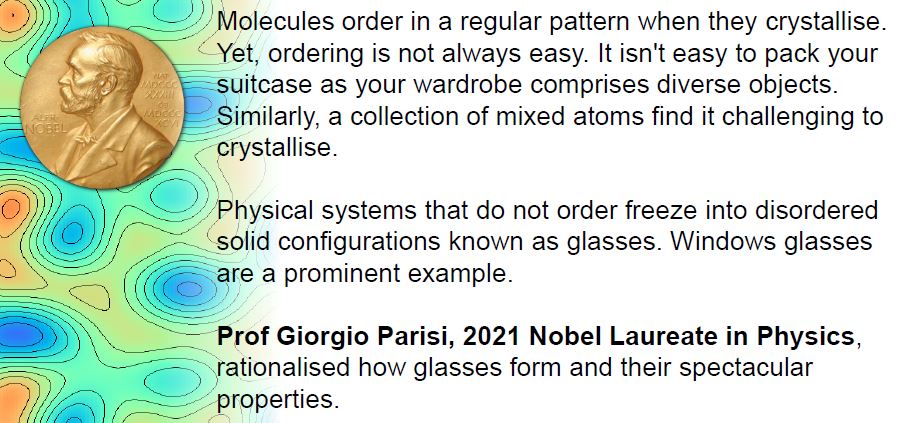Molecular, Granular and Cellular Disordered Solids have Mysterious Mechanical Properties: 2021 Nobel Prize In Physics
Associate Prof Massimo Pica Ciamarra | Assistant Chair (Internship), School of Physical & Mathematical Sciences, NTU

The 2021 Nobel Prize in Physics was awarded to Syukuro Manabe (Princeton University), Klaus Hasselmann (Max Planck Institute for Meteorology, Hamburg) and Giorgio Parisi (Sapienza University of Rome) for groundbreaking contributions to our understanding of complex physical systems.
In particular, Prof Giorgio Parisi's replica-trick formalism demonstrated the existence of transitions between diverse disordered phases and an arrest of the dynamics in systems such as disordered magnets and disordered solids, e.g. glasses and alloys, in the mathematically tractable mean-field approximation. These results provided a theoretical framework to rationalise how the viscosity of glass-forming systems increases on cooling and the mechanical properties of glasses. The replica-trick later found application in diverse optimisation problems of functions with many minima, from protein folding to machine learning.
Ongoing research at NTU by Associate Prof Massimo Pica Ciamarra tackles the mysteries of the glass transition phenomenon by which a liquid transforms into a disordered solid. One mystery concerns the abrupt slowing down of particle motion, which occurs without any noticeable structural change. The other mystery concerns the mechanical properties of disordered solids. These are difficult to predict and engineer due to the absence of crystal-like periodicity. Prof Pica Ciamarra's group also investigates the disordered-solid to liquid transition driving geophysical phenomena such as landslides and earthquakes and the transition regulating biological ones. Epithelial tissues are disordered solids that start flowing during embryonic development to shape the embryo and in adult individuals, e.g. to close a wound.

Watch the video here on 2021 Nobel Prize In Physics.















/enri-thumbnails/careeropportunities1f0caf1c-a12d-479c-be7c-3c04e085c617.tmb-mega-menu.jpg?Culture=en&sfvrsn=d7261e3b_1)

/cradle-thumbnails/research-capabilities1516d0ba63aa44f0b4ee77a8c05263b2.tmb-mega-menu.jpg?Culture=en&sfvrsn=1bc94f8_1)






